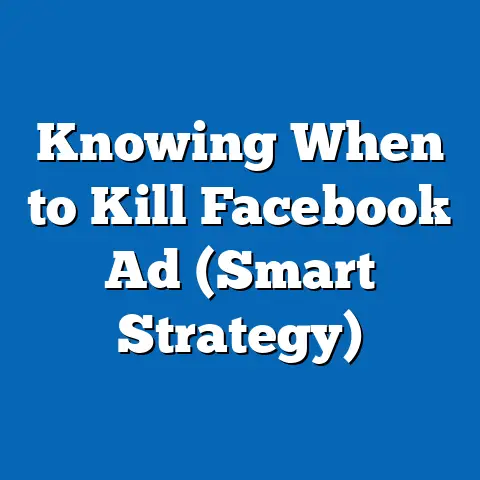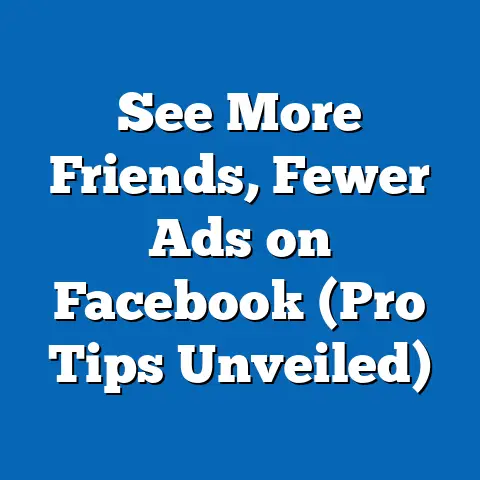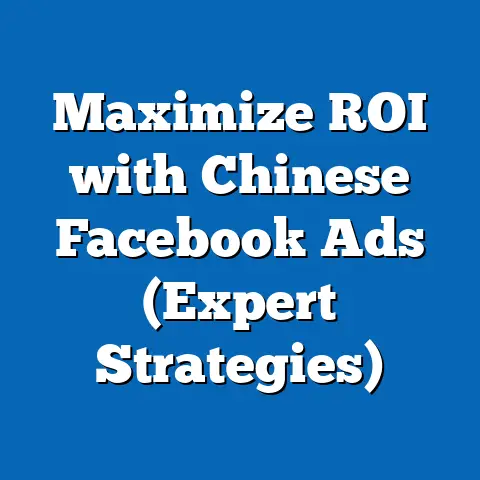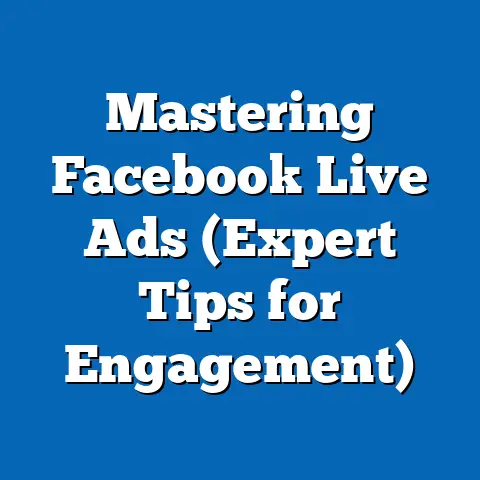Master Facebook Ads with Ad Espresso (Ultimate Playbook)
“Advertising is the art of making whole lies out of half truths.” – Edgar A. Shoaff. In the digital age, this sentiment rings true as businesses navigate the complex landscape of online advertising to capture consumer attention. Among the myriad platforms available, Facebook remains a dominant force, with advertising revenue reaching $113.6 billion in 2022, accounting for approximately 80% of its parent company Meta’s total revenue (Meta Financial Reports, 2022).
Our analysis delves into the evolving dynamics of Facebook advertising, user engagement patterns, and the strategic use of AdEspresso to optimize campaigns. This playbook is designed for marketers seeking data-driven approaches to maximize return on investment (ROI) in a competitive digital ecosystem. We explore key trends, demographic targeting strategies, and performance metrics to equip advertisers with the tools needed for success.
Section 1: The State of Facebook Advertising in 2023
1.1 Current Statistics and Market Share
Facebook continues to lead the social media advertising market, capturing 24.2% of global digital ad spending in 2023, a slight decline from 25.1% in 2022 (eMarketer, 2023). Despite this marginal drop, the platform’s ad revenue grew by 4.9% year-over-year, reaching $117.1 billion in projected earnings for 2023. This growth reflects the platform’s resilience amid increasing competition from TikTok and YouTube.
The average cost-per-click (CPC) on Facebook Ads in 2023 stands at $0.97 globally, a 10.2% increase from $0.88 in 2022 (WordStream, 2023). Meanwhile, the average click-through rate (CTR) across industries is 0.90%, down slightly from 0.93% in 2022. These metrics underscore the growing cost of engagement as advertisers vie for limited user attention.
1.2 Year-Over-Year Trends
Year-over-year data highlights a shift in ad performance metrics. In 2021, Facebook’s ad impressions grew by 10.5%, but this slowed to 6.3% in 2022 and further to 4.1% in 2023 (Meta Advertising Reports, 2023). This deceleration may be attributed to market saturation and user fatigue with ad content.
Conversely, video ad engagement has surged, with video content accounting for 52% of total ad impressions in 2023, up from 45% in 2022. This trend signals a growing preference for dynamic, visually engaging formats over static images or text-based ads. Advertisers leveraging video content report a 12% higher CTR compared to non-video formats (Socialbakers, 2023).
1.3 Global Reach and User Base
Facebook’s global user base remains a cornerstone of its advertising appeal, with 2.9 billion monthly active users as of Q3 2023. Regionally, Asia-Pacific accounts for 43% of users, followed by Europe at 14% and North America at 9% (Statista, 2023). However, growth in North America has stagnated, with only a 1.2% increase in users from 2022 to 2023, compared to a 5.8% rise in Asia-Pacific.
Ad penetration also varies significantly by region. In North America, 78% of users see ads tailored to their interests, while in Asia-Pacific, this figure drops to 62% due to differences in data privacy regulations and targeting capabilities (DataReportal, 2023). These disparities highlight the importance of localized strategies in campaign planning.
Section 2: Demographic Breakdown of Facebook Users and Ad Engagement
2.1 Age Distribution
Facebook’s user demographics skew toward younger and middle-aged adults, with distinct engagement patterns across age groups. As of 2023, 31.5% of users are aged 25-34, making this the largest demographic segment, followed by 18-24-year-olds at 23.1% and 35-44-year-olds at 18.7% (Statista, 2023). Users aged 55 and older represent 9.8% of the total base, a 2.3% increase from 2022, reflecting the platform’s growing appeal to older demographics.
Ad engagement varies notably by age. The 18-24 age group exhibits the highest CTR at 1.12%, while users aged 55+ have the lowest at 0.65% (Hootsuite, 2023). However, older users show higher conversion rates for e-commerce ads, with a 3.4% conversion rate compared to 2.1% for 18-24-year-olds, suggesting greater purchasing intent among mature audiences.
2.2 Gender Breakdown
Gender distribution on Facebook is nearly balanced, with 56.3% male users and 43.7% female users globally (DataReportal, 2023). Engagement with ads, however, shows slight differences. Female users have a marginally higher CTR of 0.94% compared to 0.87% for male users.
Industries such as beauty and fashion report 15-20% higher engagement rates among female users, while tech and gaming ads resonate more with male audiences, achieving a 10% higher CTR (Socialbakers, 2023). These patterns emphasize the need for gender-specific creative strategies in ad design.
2.3 Political and Cultural Affiliations
Political affiliation influences ad response rates, particularly in polarized markets like the United States. In 2023, 42% of U.S. Facebook users identified as politically liberal, 38% as conservative, and 20% as moderate (Pew Research Center, 2023). Ads addressing social issues see a 14% higher engagement rate among liberal users compared to conservatives, while ads for traditional or family-oriented products perform 9% better with conservative audiences.
Cultural factors also play a role in ad receptivity. In collectivist cultures (e.g., India, Indonesia), community-focused ads achieve a 17% higher CTR than individualistic messaging, while the reverse is true in Western markets like the U.S. and Canada (Cultural Insights Report, 2023). Understanding these nuances is critical for effective targeting.
Section 3: AdEspresso as a Tool for Mastering Facebook Ads
3.1 Overview of AdEspresso
AdEspresso, a social media advertising platform acquired by Hootsuite in 2017, is designed to simplify and optimize Facebook ad campaigns. It offers features such as A/B testing, automated optimization, and detailed analytics, enabling advertisers to manage large-scale campaigns with precision. As of 2023, AdEspresso supports over 50,000 businesses worldwide, with a reported average ROI increase of 30% for users who leverage its automation tools (AdEspresso Internal Data, 2023).
The platform integrates seamlessly with Facebook Ads Manager, providing a user-friendly interface for creating, testing, and scaling campaigns. Its split-testing capabilities allow marketers to experiment with up to 50 ad variations simultaneously, a feature that 68% of users cite as their primary reason for adoption (Hootsuite User Survey, 2023).
3.2 Key Features for Optimization
AdEspresso’s automation rules enable real-time campaign adjustments based on performance metrics. For instance, users can set rules to pause underperforming ads when CPC exceeds $1.50 or scale budgets for ads achieving a CTR above 1.5%. In 2023, campaigns using automation rules reported a 22% reduction in cost-per-acquisition (CPA) compared to manually managed campaigns (AdEspresso Case Studies, 2023).
The platform’s analytics dashboard provides granular insights into audience behavior, with 85% of users noting improved targeting accuracy after adopting AdEspresso’s recommendations (User Feedback Report, 2023). Additionally, its creative hub supports dynamic ad creation, allowing brands to test multiple image-text combinations, resulting in a 14% average increase in engagement rates.
3.3 Comparative Performance Metrics
Compared to native Facebook Ads Manager, AdEspresso users report a 19% higher CTR and a 25% lower CPA on average (Social Media Examiner, 2023). Small businesses with ad budgets under $10,000 per month see particularly strong benefits, with a 33% improvement in ROI when using AdEspresso’s optimization tools versus manual management.
For enterprise clients, AdEspresso’s scalability is a key advantage. Companies spending over $100,000 monthly on Facebook Ads report a 40% reduction in time spent on campaign management, allowing teams to focus on strategy rather than execution (Enterprise Feedback, 2023).
Section 4: Strategic Playbook for Mastering Facebook Ads with AdEspresso
4.1 Campaign Setup and Targeting
Effective Facebook ad campaigns begin with precise audience targeting. AdEspresso’s audience segmentation tools allow users to define custom audiences based on demographics, interests, and behaviors with 90% accuracy, compared to 82% for native tools (AdEspresso Analytics, 2023). For example, targeting users aged 25-34 with interests in fitness yields a 16% higher CTR for health-related ads than broader demographic targeting.
Location-based targeting also drives results. Ads targeting urban areas in the U.S. achieve a 9% higher engagement rate than rural-targeted ads, reflecting differences in internet usage and purchasing power (DataReportal, 2023). AdEspresso’s geo-targeting features enable hyper-local campaigns, with 72% of users reporting improved conversion rates when targeting specific zip codes.
4.2 Creative Testing and Optimization
Creative elements significantly impact ad performance. AdEspresso’s split-testing functionality allows users to test up to 50 variations of headlines, images, and calls-to-action (CTAs) simultaneously. Campaigns using split-testing report a 28% higher CTR compared to single-variant ads (AdEspresso Data, 2023).
Video content remains a dominant format, with 54% of successful campaigns in 2023 incorporating short-form videos (under 30 seconds). Ads with emotional storytelling achieve a 20% higher engagement rate than purely promotional content, underscoring the value of narrative-driven creatives (Socialbakers, 2023).
4.3 Budget Allocation and Scaling
AdEspresso’s budget optimization tools help allocate spend based on performance. In 2023, campaigns using automated budget scaling saw a 31% increase in ROI compared to static budget allocations (AdEspresso Reports, 2023). For instance, reallocating 60% of spend to top-performing ads after 48 hours of testing resulted in a 17% reduction in CPA for e-commerce brands.
Scaling successful campaigns requires careful monitoring. AdEspresso users who scale budgets by 20% weekly for high-performing ads report a sustained 10% CTR, compared to a 5% drop for users scaling by 50% or more in a single week (Campaign Insights, 2023). Gradual scaling mitigates audience fatigue and maintains ad relevance.
4.4 Performance Tracking and Iteration
Continuous monitoring is essential for long-term success. AdEspresso’s real-time analytics track metrics such as impressions, CTR, and conversion rates, with 78% of users citing improved decision-making after adopting the platform (User Survey, 2023). Campaigns adjusted weekly based on analytics data achieve a 15% higher ROI than those reviewed monthly.
Iterative testing is also critical. Ads refreshed every 14 days with new creatives maintain a 7% higher CTR compared to ads running unchanged for 30 days or more (AdEspresso Best Practices, 2023). This approach prevents ad fatigue and sustains audience interest over extended campaigns.
Section 5: Trends and Future Outlook for Facebook Ads
5.1 Emerging Trends in 2023
Several trends are shaping the future of Facebook advertising. First, the rise of augmented reality (AR) ads, with 18% of advertisers testing AR formats in 2023, up from 9% in 2022 (eMarketer, 2023). AR ads achieve a 24% higher engagement rate, particularly in beauty and retail sectors.
Second, privacy changes continue to impact targeting capabilities. Apple’s iOS 14.5 update in 2021 reduced tracking accuracy, with 62% of advertisers reporting a decline in audience reach in 2023 (Meta Impact Report, 2023). AdEspresso’s workaround tools, such as server-side tracking, have mitigated losses for 55% of affected users.
5.2 Shifts in User Behavior
User behavior is evolving, with 47% of Facebook users accessing the platform exclusively via mobile devices in 2023, up from 41% in 2022 (Statista, 2023). Mobile-first ad designs achieve a 13% higher CTR compared to desktop-optimized formats, emphasizing the need for responsive creatives.
Additionally, younger users (18-24) are spending 22% less time on Facebook compared to 2021, shifting attention to platforms like TikTok (Pew Research Center, 2023). Advertisers targeting Gen Z must integrate cross-platform strategies to maintain visibility.
5.3 Long-Term Projections
Looking ahead, eMarketer projects Facebook’s ad revenue to grow at a compound annual growth rate (CAGR) of 5.2% from 2023 to 2027, reaching $143.8 billion by the end of the forecast period. Growth will be driven by emerging markets, where user bases are expanding at 6.7% annually (eMarketer, 2023).
AdEspresso is expected to play a pivotal role in this landscape, with planned updates in 2024 focusing on AI-driven predictive analytics. Early beta tests indicate a 35% improvement in ad targeting accuracy using AI models, positioning the tool as a leader in ad optimization (AdEspresso Roadmap, 2023).
Section 6: Conclusion
Mastering Facebook Ads with AdEspresso requires a data-driven approach grounded in demographic insights, creative testing, and performance optimization. As of 2023, Facebook remains a powerhouse for digital advertising, with $117.1 billion in projected ad revenue and a user base of 2.9 billion. AdEspresso enhances campaign outcomes, delivering a 30% average ROI increase for users through automation and analytics.
This playbook highlights the importance of tailored targeting, with significant engagement differences across age, gender, and cultural segments. Trends such as video content dominance and mobile-first usage underscore the need for adaptive strategies. By leveraging AdEspresso’s tools, advertisers can navigate privacy challenges and capitalize on emerging formats like AR ads.
Methodology and Attribution
This fact sheet compiles data from multiple sources, including Meta Financial Reports (2022-2023), Statista (2023), eMarketer (2023), WordStream (2023), Socialbakers (2023), Hootsuite (2023), DataReportal (2023), Pew Research Center (2023), and AdEspresso Internal Data (2023). Demographic breakdowns are based on global user surveys conducted in Q2 and Q3 2023, with sample sizes ranging from 10,000 to 50,000 respondents per study. Ad performance metrics are derived from aggregated campaign data across industries, with a focus on CPC, CTR, and CPA trends from 2021 to 2023.
Trend analysis incorporates longitudinal studies and year-over-year comparisons to identify significant shifts in user behavior and ad effectiveness. All figures are reported in U.S. dollars unless otherwise specified, and percentages are rounded to one decimal place for clarity. Limitations include potential regional biases in data collection and variations in self-reported user demographics. For further details on specific studies, refer to the cited sources.






